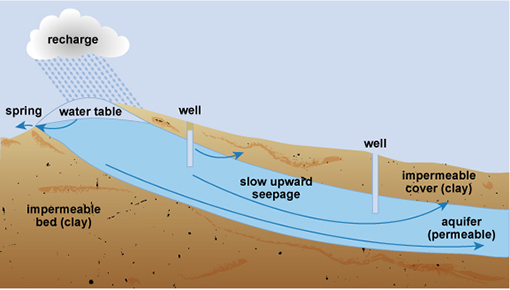3.3 Groundwater
Groundwater was defined in Study Session 1 as water that is found underground within rocks. Its presence depends primarily on the type of rock. Permeable rocks have tiny spaces between the solid rock particles that allow water and other fluids to pass through and to be held within the rock structure. The layers of rock that hold groundwater are called aquifers. Figure 3.3 shows how groundwater in an aquifer is replenished by rain and other forms of precipitation (any form of water, such as rain, snow, sleet or hail that falls to the Earth’s surface, shown in the diagram as ‘recharge’) that has percolated (passed through a porous substance, or through small holes) downward into the aquifer. The level of water below ground is called the water table. Groundwater can be extracted from wells or collected from springs.

The depth that groundwater is taken from and the types of permeable rock it has passed through are important factors that affect its quality. Groundwater, particularly from deep sources, may provide water of good microbiological quality. This is because bacteria, protozoa, viruses and helminths are filtered from the water as it passes through the layers of soil and rock. Groundwater sources are therefore preferable to surface water sources. However, groundwater can contain chemical contaminants, as indicated in Table 3.1, which lists the advantages and disadvantages of using groundwater as a water source.
| Advantages | Disadvantages |
Likely to be free of pathogenic bacteria Usually free of turbidity and colour Can usually be used without further treatment Can often be found in close vicinity to consumers Economical to obtain and distribute The water-bearing soil or rock provides a natural storage point | Often has a high mineral content (i.e. has naturally occurring substances that are not from living organisms) such as calcium, magnesium, iron and manganese Usually requires pumping for extraction May have a high level of bicarbonate, carbonate and chloride Poor in oxygen content Can contain chemical contaminants such as arsenic, fluorides and nitrates If it gets polluted, treatment can be difficult to achieve |
Several factors influence the likelihood of groundwater becoming contaminated from a polluting source such as a pit latrine. The geology is important because in areas with permeable rocks, or where there are small cracks in the rock formation, fluids can pass through more easily into the aquifer. Other factors include the depth of the pit and its vertical distance from the water table. In Ethiopia, federal guidelines state that latrines must be sited at least 30 metres from any water source to be used for human consumption and if on sloping ground be lower than the source (MoH, 2004).
Why should a well be located uphill from any possible sources of pollution?
The natural flow of the groundwater follows the law of gravity, and will be downhill. The well should be sited so that any pollutants going into the soil that enter the groundwater do not get into the water in the well. So, the best place for a well would be uphill of the pollutant source.
3.2 The situation in Ethiopia
